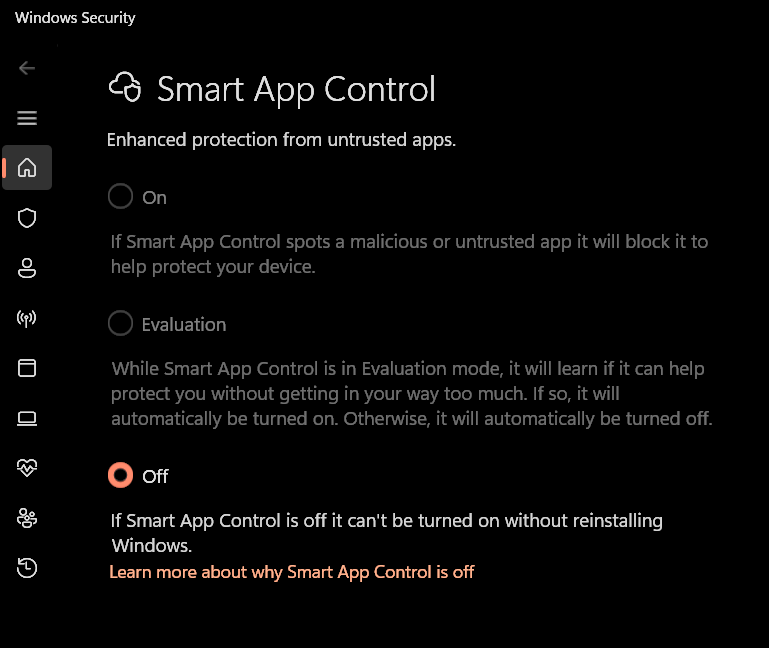Microsoft's Smart App Control blocks malware and has 'lighter impact on your PC’s performance'
Guilty until proven innocent approach may save your CPU cycles.

With Windows 11 22H2, Microsoft introduced a new component to its security suite, aiming to prevent malicious applications, dubbed Smart App Control (SAC). This feature complements Microsoft Defender, blocking untrusted or unknown code from executing on a proactive basis. Now, in an updated blog post pushing the feature, Microsoft claims a performance boost compared to traditional AV solutions, though small print indicates you will require a fresh Windows installation to use this feature.
Traditional antivirus software, such as Microsoft Defender, adopts an "Innocent until proven guilty" approach. These solutions are largely reactive, trusting programs until their behavior triggers an alert. Microsoft Defender employs signature-based detection, behavioral checks (heuristics), and cloud protection to prevent malicious software on your system. When faced with novel (zero-day) malware or polymorphic threats, which can bypass signature checks, Defender falls back to heuristics, observing the malware's actions until it detects suspicious behavior.
Here's where Smart App Control enters the fray, employing a proactive methodology, operating on the principle of "Guilty until proven innocent." It assesses the application's security by vetting it against Microsoft's Intelligence Security Graph (a cloud-based reputation service). If this test is inconclusive, it attempts to validate the application's digital signature, to ensure its origin from a trusted developer. The application is blocked by Windows Security if it is predicted to be malicious in the first check or unsigned in the second check.

Essentially, SAC bypasses traditional behavioral checks by ensuring only verified applications can run on your system. Although Microsoft claims Smart App Control offers a performance boost over traditional antivirus solutions, it is designed to operate in parallel with Windows Defender. Unlike Windows Defender, if SAC deems a program malicious, it cannot be flagged as a false positive or whitelisted. As such, SAC is likely to be a poor fit for enthusiasts or developers, better serving enterprise systems or individuals who aren't as tech-savvy.
To prevent such conflicts, Microsoft runs Smart App Control through an evaluation phase to determine if this feature would hinder your day-to-day activities. This is a one-way street: if SAC is deemed unsuitable for your system, it will be disabled and can only be re-enabled by reinstalling Windows. Likewise, if you decide to turn it off yourself, you won't be able to simply switch it back on.
Follow Tom's Hardware on Google News to get our up-to-date news, analysis, and reviews in your feeds. Make sure to click the Follow button.
Get Tom's Hardware's best news and in-depth reviews, straight to your inbox.

Hassam Nasir is a die-hard hardware enthusiast with years of experience as a tech editor and writer, focusing on detailed CPU comparisons and general hardware news. When he’s not working, you’ll find him bending tubes for his ever-evolving custom water-loop gaming rig or benchmarking the latest CPUs and GPUs just for fun.
-
micheal_15 Whilst it looks good on paper, Smart App Control is designed to prevent you using ANY sort of rival to microsoft products. Blocks Open Office, Libre etc.Reply
Blocks any program similar to Powerpoint. Blocks AWS software (competing with Azure) etc.
Wouldn't be surprised if it blocks 'rivals' to the microsoft store such as Steam or Epic Store etc with an 'accidental' update patch.... -
USAFRet Reply
Any documentation on this?micheal_15 said:Whilst it looks good on paper, Smart App Control is designed to prevent you using ANY sort of rival to microsoft products. Blocks Open Office, Libre etc.
Blocks any program similar to Powerpoint. Blocks AWS software (competing with Azure) etc.
Wouldn't be surprised if it blocks 'rivals' to the microsoft store such as Steam or Epic Store etc with an 'accidental' update patch.... -
BFG-9000 Coming soon: Microsoft to switch all users to Windows S mode to protect customers from harm. S mode is streamlined for security and performance so allows only apps from the Microsoft Store and requires using Microsoft Edge for browsing.Reply -
Alvar "Miles" Udell I had to check this to see if it were AI written because this feature has been in Windows for over 2 years and is unlikely to be used because it requires a fresh installation of Windows from within Windows, it doesn't ask if you set it up from a bootable ISO.Reply
Still, it's a good thing for people who normally just use a small number of usually major programs, like office workers or people who basically just use it for internet, email, and casual games, but the difficulty in activating it just defeats its purpose. -
Hooda Thunkett Sounds okay for a work computer that only runs default applications, but if your work needs any kind of custom software, this would be useless. Assuming said custom software wasn't written by a trusted developer.Reply
Of course it would be useless against supply-chain attacks... -
USAFRet Reply
Surface tablet/laptop I bought about 18 months ago was Windows 11 S.BFG-9000 said:Coming soon: Microsoft to switch all users to Windows S mode to protect customers from harm. S mode is streamlined for security and performance so allows only apps from the Microsoft Store and requires using Microsoft Edge for browsing.
Absolutely useful, for those family members that need all that handholding.
Easily reverted out of S mode into regular Win 11. -
Amdlova I want to know when the microsoft will block IT self. Micosoft is the Malware and the trojan horse in every update.Reply